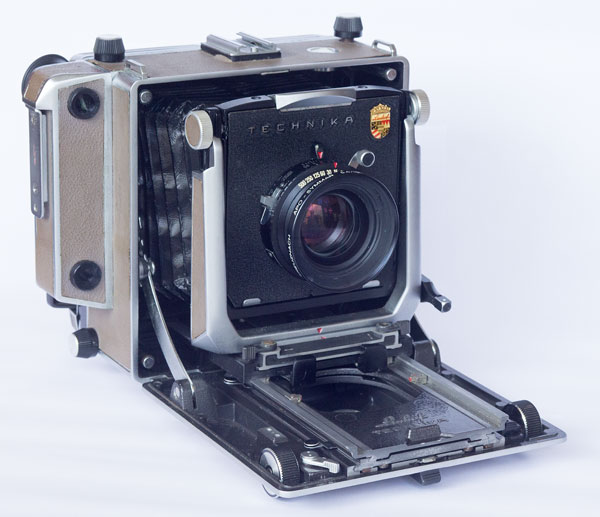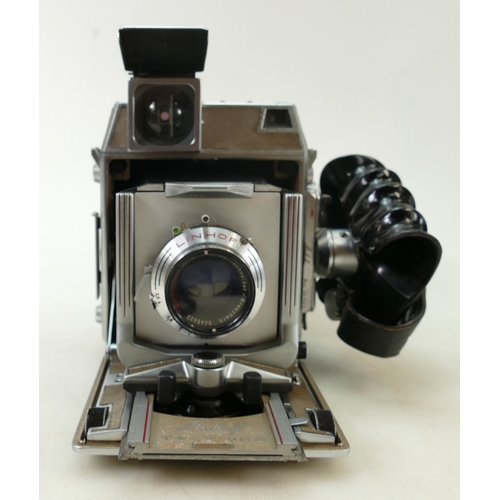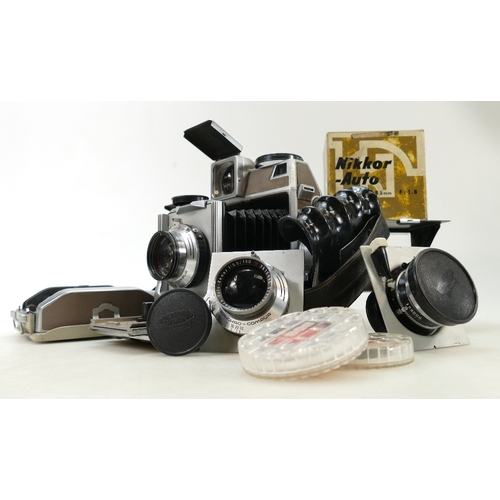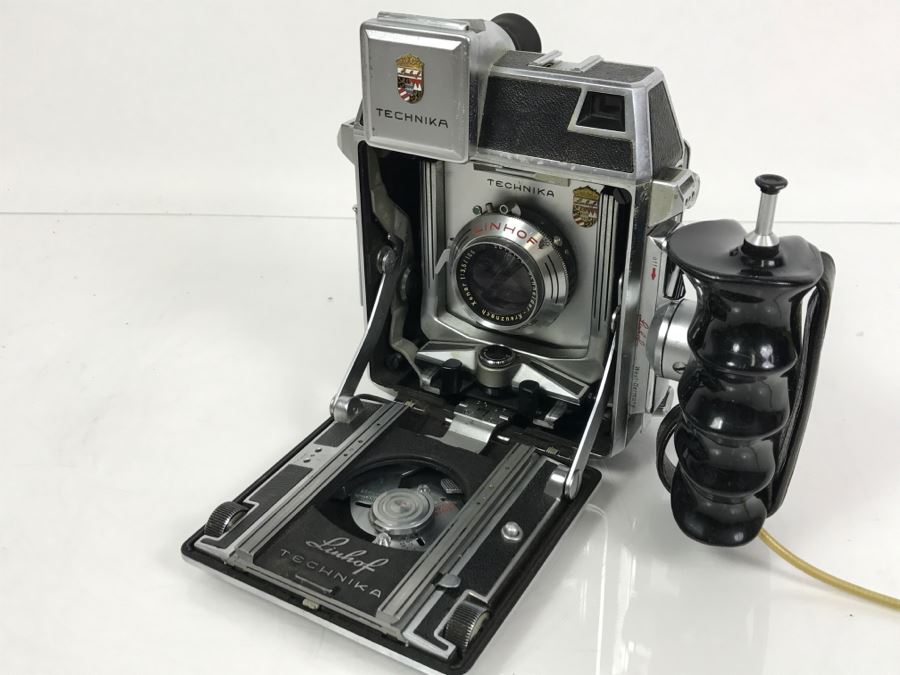Linhof Technika Buyers Guide
- Linhof Technika Serial Number Camera Nikon
- Linhof Technika 6x9
- Linhof Technika Serial Number Camera Online
- Linhof Technika Iv
- Kumpulan Serial Number Idm
- Linhof Technika 3000

- Tell us what you think - opens in new window or tab Jump to navigationJump to search. Linhof is a German company, founded in Munich in 1887 by Valentin Linhof. The company is well known for making premium rollfilm and large format film cameras. Linhof initially focused on making camera shutters and developing the first leaf shutter, which became part of Compur.
- The Linhof Master Technika camera has achieved a certain worldwide cult status. It is noble too, respected throughout the world for its outstanding design and it. Despite the lower serial number than 76076, Bob Salomon says it dates from about 1960 - or about the middle of the model-run.
This buying guide is meant to be informative and provide accurate information so you can buy the best camera possible, this information comes from experience servicing Technika cameras showing many different issues. We will continue to update, revise and pass on valid information in this guide.
*I do not agree with the suggested modifications listed in other Technika buying guides found online, these guides contains an abundance of misinformation and should be interpreted loosely.*

This guide is for Technika IV, V and Master cameras. The same basics knowledge can be applied to Technika III, though different models of III's have their own issues not specifically addressed here, in the future, time permitting..

1640411: Linhof Technikar 220 camera. Serial number: 7521065. SKU: 03337Follow us on Instagram: @revereauctions.
Most of the vintage Technika cameras to be found now are 25-50 years old (even older for Technika III), it is reasonable to assume any camera you select, despite the condition/pictures and description will need a CLA service to be brought back to proper operating condition. The selling dealers or owners have no point of reference or knowledge to test functions and know if they are correct or out of tolerance.
Modern bellows generally last 10-15 years, so a camera built in the 1970s/80s/90s is probably going to need bellows replaced at minimum. The interest in large format photography again has brought many cameras out of the woodwork and into the open market for sale, this is a good thing, but double edged for buyers who believe a camera will arrive as turn-key ready to shoot. This is almost never the case for a vintage Technika.
Having hundreds of examples of Linhof Technika cameras pass through my hands each year, I can say the japanese sellers especially on eBay are overly ambitious and creative in the description of cameras. The words 'Top Mint' 'Near Mint' 'EX+++ Like Mint' mean nothing and should all be considered hyperbole. These amazing cameras are now aging and it is wise to budget for a CLA and bellows replacement before putting into regular use again.
The goal is to have an amazing tool for photography, that operates as intended so can concentrate on imagery not fighting with a cranky Technika. Another note is the cameras sold by KEH, Cat labs and some other used dealers are not much more desireable in actual function vs. grading rate. I routinely see these cameras described as one thing end up being completely in need of a full rebuild. It is just part of vintage cameras of this age, but the dealers do not advertise properly what they are selling.
Also, absolutely do not buy one of these naked stripped cameras missing all covering advertised as 'metal field camera', it is absurd that a dealer will remove the covering of a camera in order to increase profits. The covering, if original, can be matched for missing pieces or given new skin entirely, but a camera stripped and missing all pieces of covering is a disservice to all the effort that went into building it in the first place. There are also multiple cover shims under the original coverings that protect vital service parts of the camera.
A nice used Technika should be reasonably priced and in good working order . Beware of cameras with bargain prices or home 'modifications'. Your bargain camera can quickly add up to a much higher cost when it needs service. These bargain/home modified cameras do not retain their value and defeat the purpose of buying a Linhof. A camera with issues can be addressed, but don't purchase a camera bargain priced believing it will be a good investment, as repairs will quickly add up.
Some insight of what look for, what to avoid and reasonable expectations when looking to buy a used Technika:
1. Bellows should be supple without pinholes, excessive wear or taped corners. They should be installed straight inside the camera, many people who replace bellows install them crooked and sometimes even upside down (the seam of the bellows should always be on the bottom and not visible).
They should look 'right' and have correct spacing on all sides. Take the rotating back off the camera and check to see if the rear bellows edges are reasonably straight and not excessive amount of adhesive on the edges. If the bellows show exposed paper from cracking (as common with certain generations of Technika bellows) they need to be replaced. Check not just the corners but especially the bottom of the bellows for thinning spots and light leaks. A couple pin holes can be patched, but this is a temporary fix and others will start to appear over time. The Chinese replacement bellows are not very good, have a strong chemical odor and not consistent in build quality either, avoid them. A Technika should have the correct Linhof bellows installed.
The aftermarket Chinese bellows are also too thick, which does not allow the front standard to retract far enough back into the camera before closing. This causes the front standard to hit the middle track when closing. This in turn can also cause the rangefinder cam linkage to not disengage properly.. The correct Linhof bellows are the solution.
With the camera front standard facing you, look at the right side black clamp on the bottom of the front standard, if it has scratches on this part it is because the camera is not closing properly, either from aftermarket bellows or from the rangefinder cam linkage not disengaging properly when closing the camera. This leads to the cam wheel guiding linkage on the the middle track hitting the front standard clamp and creating these marks, essentially the middle track is pushing against the front standard to force into the camera body to create enough clearance for closing. I can look at pictures only of a camera and spot this immediately as the camera front standard is not retracting enough into the body before closing the camera. It can be repaired but it should be noted.
2. Does the camera show excessive oil in the door bed? Often owners just keep adding lubrication to make the camera feel smoother rather than addressing the cause of the problem. Ask if it has been lubricated and what type was used (WD40 is not a good answer). If the camera looks greasy/oily, there is likely a bigger problem being masked. Vaseline causes it's own issues in time, there are superior synthetic lubricants available today that do not break down over time.
If you are looking at a newer model Master Technika (mid 1990s-2005), pay close attention to the stiffness of focusing and movements. There was a different type of lubricant used on certain productions, it deteriorates and becomes almost glue-like, freezing the movements. We've seen 2000 and Classic models of this era that are barely movable, despite being in excellent condition. This can be corrected in with a CLA.
3. Check the focusing track, including the extensions for ridges and grooves, especially the lower track, run your finger along the track to feel if any spots are rough. Prolonged use of a camera with improper fit of the focusing track creates these ridges and grooves, sometimes they can be corrected, sometimes the entire track must be replaced. Avoid cameras showing these. Cameras with excessive corrosion to the chrome or rust showing on the internal hardware, have been improperly stored and will have issues being serviced. Avoid camera with excessive corrosion.
Linhof Technika Serial Number Camera Nikon
4. Check the rise/fall geared track. Technika IV used metal tracks that are less likely to have stripped gears. Technika IV and Masters use a black plastic track, which is very smooth, but prone to stripping if the ratchet rise is not used gently. Most often the first few teeth at the bottom of the track are stripped. I've seen everything from epoxy to gaffers tape placed here to make it seem like the rise/fall works properly, it's easy to miss if you don't look closely. If the black geared track shows signs of being stripped, is should be replaced, continued use with a stripped track will break the ratchet rise. The ratchet rise lever, both white plastic tip and later black aluminum, should be serviced if the track is stripped. When using the ratchet rise, it should travel through the full range of movement before you crank it again, this will prolong the life of the internal mechanism.
Linhof Technika 6x9
5. Swing movements should be smooth in both directions, the lock engages at the resting position only and should snap firmly into place (the movements do not lock when you apply your swing, only the resting is a 'locked' position). The shift movements should be smooth in both directions with a zero-stop click detent at the aligned red arrows. If either of these movements are stiff, it needs a CLA. Continued use with stiff movements will wear out components. Tilt movements should click in and out easily, with smooth movement in both direction. The tilt control knob should loosen and tighten smoothly. If the tilt engaging wheel is hard to push, it needs to be serviced before it seizes.
6. Check the focusing track lock lever, when in the locked position, gently attempt to turn the focusing wheels, the track should not move. When in unlocked position, you should not feel any resistance from the lock when turning the focusing wheels. If the track moves when lock is engaged, service is required. If the lock wiggles around excessively when engaged, it needs to be serviced or replaced.
7. Does the front standard have the proper amount of tension on the track? It should release easily and lock into place firmly, attempt to gently push the front standard towards the camera housing with locked engaged, it should not shimmy backwards on the track or wobble back and forth. When released, you should be able to move the standard forward and backward smoothly without feeling any rough spots. Push and pull the standard back and forth from the inside the camera to focusing track, the transition should be smooth and not feel like your hitting the sides of the track or having to apply excessive force. If this action doesn't feel smooth or requires excessive force to move the standard, it needs to be serviced and realigned. Continued use if this action is rough with break the standard base, tension lock and possibly ruin the track.
*When opening a Technika, first push the extension track backwards to the front standard rest track inside the camera body. The tracks should meet each other and eliminate the gap between. Only then should you release the front standard and pull onto the extension track. Once you pull the front standard onto the track, then reset extension track into normal 'zero' locked position.
The reason for doing this? By 'jumping' the gap and just pulling out the front standard, owners often break the corners off the front standard baseplate which guides along the track. The tension mechanism is also usually damaged this way. This is a costly repair and one of the most common. If you are considering a camera, look at this front standard baseplate and make sure there are no 'chipped' corners missing. Usually one corner is broken, the camera continues to be used, another corner is broken and then front standard will not lock into place, it's very easy to damage lenses from the front standard falling off the track.*
8. The locking knobs of the top and sides of the camera should travel smoothly, and stop at the fully unlocked position, they should not screw all the way off the camera. The two spring catches to release the back frame movements should be smooth to unlock, and both should lock easily, if they do not lock or unlock easily, service is required. Back movements should be smooth in all directions, not excessively loose either. Look at the back movement extension rods, they should be straight and not rusted or excessively oily.
9. If the camera has original leather, all pieces should be intact and matching, look for signs of being refit to the camera with poor glue jobs. If the camera has been recovered, ask if the metal cover shims with retained. These protect vital internal screws and that not be exposed to adhesives. You do not need strong chemicals to remove the original glue on a Technika when recovering, often people create bigger issues for service by exposing vital internal screws to these chemicals. If you *must* choose to recover a camera on your own..
All that is required:
An Xacto knife
Straight razor blades
Alcohol
Charcoal Lighter fluid (to remove stubborn adhesives, use lightly)
Patience and a lot of attention to detail. All old adhesive needs to be removed completely. It is a skill to recover a camera well. We offer recovering service for all models and do NOT use CameraLeather.com or junk Chinese leather kits due to poor fit quality and reliability of delivery. We custom laser cut leather coverings as needed.
10. Check the ground glass back to be sure it was properly fitted. Earlier Techika IV do not have metal 'zero' shims under the ground glass thus Fresnel lens is placed behind ground glass (closest to lens) groove side down.
Technika IV / Masters there should be four metal shims that zero the ground glass. Fresnel lens is placed on top of ground glass (closest to you) groove side side, then secured in place with Fresnel Clips. A Technika V / Master should have these four metal shims under the ground glass. If the shims are not present, someone has switched the back from a Technika IV (this is a common problem with used Technika V bodies and inspect/ask the seller).
11. Whether you use the rangefinder or not, with a focusing cam installed watch to see the cam travels smoothly throughout the focusing range. This is often 'adjusted' by photographers and out of alignment. The cam should never get 'stuck' requiring you to free it with your fingers. Look around the cam holder for damage to the door, often people will remove the cam and try to close the camera, leaving scratches and gouges on the door bed near the bottom hinges. The cam should 'engage' when you pull out the front standard and 'disengage' when you push the standard back into the camera.
The focusing cam should travel smoothly, rack the focus out forward until the cam disengages, then rack it back towards the camera, make sure the cam traveler catches the cam properly and the cam does not slip under the cam guider. You can often observe used focusing cams that have a long grinding / marring on the top by the serial/focal length engraving, this is caused at some point by the cam guider travel jumping on top of the focusing cam and the photographer continuing to use the camera this way, sometimes it was simply the door struts were dropped and the cam slipped under, other times the linkage is bent . When a focusing cam is bent, it will to no longer match the rangefinder at all distances.
Pay close attention to the focusing cam when the front standard is retracted all the way back inside the camera. The front standard controls the engaging and disengaging of the focusing cam linkage. With the front standard in the resting position inside the camera, the rangefinder cam should be in the 'locked' position and when you move focusing knobs of the track forward then backwards to test, the cam should not engage freely. If the cam moves freely when in the disengaged position, service is needed.
Also, it is often seen if the cam is not disengaging properly, opening and closing the camera, will start to pull the rangefinder cam out of it's shoe each time the camera is opened. This can then bend cams and make them no longer accurate.
If your camera has a rangefinder, it should always have a focusing cam installed so the camera opens and closes smoothly, even if you don't use the rangefinder regularly. Often the linkage that holds the focusing cam is bent and requires repair from photographers opening and closing the camera without a focusing cam installed.
I would not advise buying a camera if someone has removed the rangefinder themselves, as you never know what else has been 'adjusted'. Removing the rangefinder on a Super Technika decreases the resale value up to 50% and saves only a small amount of weight. These are very special cameras and should be kept original. If you desire a non-rangefinder Technika, buy one that was factory built this way instead of removing a complex and precision fitted rangefinder system...
12. The spring loaded camera door bed should open and close smoothly. You should feel the arm bed springs engage and the camera should open and close smoothly. Early Technika IV cameras are prone to having door problems and often 'fixed' with improper screws and methods.. Look for sloppy glue or hardware that is not original. There is not a single Phillips head screw inside Technikas IV V and older Master, if you see a Phillips head screw it is not original and probably not Metric either, meaning the thread has been stripped and an SAE screw has been used to cover this up.
13. Check the door latch to make sure it is not loose and the camera stays closed when the latch is engaged. It also should not be tight and look to make sure someone hasn't oiled or put adhesive on the latch. Look at the door latch catch inside the body and make sure it is not bent or broken.

14. Technika IV are prone to have the door strut spring hold down screw on the camera bed strip out over time. Check the door struts for spring-action and watch the screw used to attach the strut to the camera bed, it should not rotate when moving the struts, if it does, the threads are stripped. It can sometimes be re-tapped and a helicoil thread repair insert is used, if the thread is too far gone then a longer hold down screw and locking nut are the only option. Technika V also can experience door strut issues in time.
While the door strut attachment to bed was greatly improved on the Technika V (the spring action was moved inside the camera body vs. the bed on the Technika IV), over time the springs start to weaken from use, also the screws holding the spring assembly inside the camera become loose and the guiding mechanism for the struts become bent. It can be repaired, but it something to check for when inspecting a Technika V.
- Avoid the early Technika IV cameras before 66,175 serial number. Internal changes were made in production and these cameras have specific parts that were produced for only a short time. These are not worth retrofitting for end user when certain repairs are required. We can modify the IVs as needed, but it's unless the camera is in really nice cosmetic condition, it's probably not worth it for end user.
-While Technikas appear simple in construction, they are very complex built cameras, the strict tolerances and fit require a great deal of skill and knowledge to service and maintain a proper working camera. Unfortunately, Linhof camerasoften suffer from home repairs, performed by owners who are guessing, at best, as to how to service a Technika. Avoid cameras showing home repairs.
Linhof Technika Serial Number Camera Online
As with any precision instrument, Technikas require routine maintenance to continue optimal performance.
Buy the best camera you can, keep it working properly and concentrate on your photography.
We maintain a large collection of Linhof house cameras for testing and comparison purposes, multiples of all the different variations. There have been many changes to the construction of Technikas over the years, both minor and major. Often Technika owners don't have a basis for comparison of what the camera 'should' feel like. After service a Technika feels super smooth and just 'right'. Most often cameras sent for service have very stiff focusing and movements. A proper working and aligned Technika should have a very smooth feeling, without resistance or stiff feeling of any actions
--
*A NOTE ABOUT THE TECHNIKA CAMERAS COMING OUT OF JAPAN ON EBAY*
Linhof Technika Iv
- We offer a complete and thorough 40 point Technika inspection service evaluating all camera functions. If you've recently acquired a camera and want to have it's operating condition checked, you can contact us for sending instructions. This inspection is free and can help determine whether a you should keep or return a camera to the seller. Often we see cameras purchased several months prior, only for the buyer to realize the camera has many issues and require a CLA service.
- Currently there is a flood of the market of used Technika cameras coming out of Japan, due to their down economy and low interest in Linhof cameras there currently. While some of the cameras might seem to have low prices, buyers should beware of the condition represented and take it with a grain of salt. 95% of these cameras will be due for a CLA service.
Kumpulan Serial Number Idm
